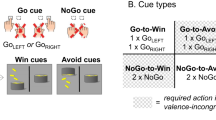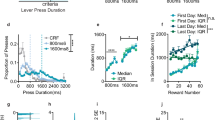Abstract
Our ability to judge the consequences of our actions is central to rational decision making. A large body of evidence implicates primate prefrontal regions in the regulation of this ability. It has proven extremely difficult, however, to separate functional areas in the frontal lobes. Using functional magnetic resonance imaging, we demonstrate complementary and reciprocal roles for the human orbitofrontal (OFC) and dorsal anterior cingulate cortices (ACd) in monitoring the outcome of behavior. Activation levels in these regions were negatively correlated, with activation increasing in the ACd and decreasing in the OFC when the selected response was the result of the participant's own decision. The pattern was reversed when the selected response was guided by the experimenter rather than the participant. These results indicate that the neural mechanisms underlying the way we assess the consequences of choices differ depending on whether we are told what to do or are able to exercise our volition.
This is a preview of subscription content, access via your institution
Access options
Subscribe to this journal
Receive 12 print issues and online access
$209.00 per year
only $17.42 per issue
Buy this article
- Purchase on Springer Link
- Instant access to full article PDF
Prices may be subject to local taxes which are calculated during checkout








Similar content being viewed by others
References
Ito, S., Stuphorn, V., Brown, J.W. & Schall, J.D. Performance monitoring by the anterior cingulate cortex during saccade countermanding. Science 302, 120–122 (2003).
Paus, T. Primate anterior cingulate cortex: where motor control, drive and cognition interface. Nat. Rev. Neurosci. 2, 417–424 (2001).
Elliott, R., Dolan, R.J. & Frith, C.D. Dissociable functions in the medial and lateral orbitofrontal cortex: evidence from human neuroimaging studies. Cereb. Cortex 10, 308–317 (2000).
Elliott, R., Friston, K.J. & Dolan, R.J. Dissociable neural responses in human reward systems. J. Neurosci. 20, 6159–6165 (2000).
Berns, G.S., McClure, S.M., Pagnoni, G. & Montague, P.R. Predictability modulates human brain response to reward. J. Neurosci. 21, 2793–2798 (2001).
O'Doherty, J., Critchley, H., Deichmann, R. & Dolan, R.J. Dissociating valence of outcome from behavioral control in human orbital and ventral prefrontal cortices. J. Neurosci. 23, 7931–7939 (2003).
Botvinick, M.M., Braver, T.S., Barch, D.M., Carter, C.S. & Cohen, J.D. Conflict monitoring and cognitive control. Psychol. Rev. 108, 624–652 (2001).
Holroyd, C.B. & Coles, M.G. The neural basis of human error processing: reinforcement learning, dopamine, and the error-related negativity. Psychol. Rev. 109, 679–709 (2002).
O'Doherty, J., Kringelbach, M.L., Rolls, E.T., Hornak, J. & Andrews, C. Abstract reward and punishment representations in the human orbitofrontal cortex. Nat. Neurosci. 4, 95–102 (2001).
Kringelbach, M.L. & Rolls, E.T. The functional neuroanatomy of the human orbitofrontal cortex: evidence from neuroimaging and neuropsychology. Prog. Neurobiol. 72, 341–372 (2004).
Shidara, M. & Richmond, B.J. Anterior cingulate: single neuronal signals related to degree of reward expectancy. Science 296, 1709–1711 (2002).
Rolls, E.T., Hornak, J., Wade, D. & McGrath, J. Emotion-related learning in patients with social and emotional changes associated with frontal lobe damage. J. Neurol. Neurosurg. Psychiatry 57, 1518–1524 (1994).
Tremblay, L. & Schultz, W. Relative reward preference in primate orbitofrontal cortex. Nature 398, 704–708 (1999).
Shima, K. & Tanji, J. Role for cingulate motor area cells in voluntary movement selection based on reward. Science 282, 1335–1338 (1998).
Procyk, E., Tanaka, Y.L. & Joseph, J.P. Anterior cingulate activity during routine and non-routine sequential behaviors in macaques. Nat. Neurosci. 3, 502–508 (2000).
Hadland, K.A., Rushworth, M.F., Gaffan, D. & Passingham, R.E. The anterior cingulate and reward-guided selection of actions. J. Neurophysiol. 89, 1161–1164 (2003).
Saxena, S., Brody, A.L., Schwartz, J.M. & Baxter, L.R. Neuroimaging and frontal-subcortical circuitry in obsessive-compulsive disorder. Br. J. Psychiatry suppl. 35, 26–37 (1998).
Frith, C.D., Blakemore, S. & Wolpert, D.M. Explaining the symptoms of schizophrenia: abnormalities in the awareness of action. Brain Res. Brain Res. Rev. 31, 357–363 (2000).
Duncan, J. & Owen, A.M. Common regions of the human frontal lobe recruited by diverse cognitive demands. Trends Neurosci. 23, 475–483 (2000).
Koski, L. & Paus, T. Functional connectivity of the anterior cingulate cortex within the human frontal lobe: a brain-mapping meta-analysis. Exp. Brain Res. 133, 55–65 (2000).
Frith, C.D., Friston, K., Liddle, P.F. & Frackowiak, R.S. Willed action and the prefrontal cortex in man: a study with PET. Proc. R. Soc. Lond. B 244, 241–246 (1991).
Rushworth, M.F., Hadland, K.A., Paus, T. & Sipila, P.K. Role of the human medial frontal cortex in task switching: a combined fMRI and TMS study. J. Neurophysiol. 87, 2577–2592 (2002).
Jueptner, M., Frith, C.D., Brooks, D.J., Frackowiak, R.S. & Passingham, R.E. Anatomy of motor learning. II. Subcortical structures and learning by trial and error. J. Neurophysiol. 77, 1325–1337 (1997).
Carmichael, S.T. & Price, J.L. Connectional networks within the orbital and medial prefrontal cortex of macaque monkeys. J. Comp. Neurol. 371, 179–207 (1996).
Picard, N. & Strick, P.L. Motor areas of the medial wall: a review of their location and functional activation. Cereb. Cortex 6, 342–353 (1996).
Morecraft, R.J. & Van Hoesen, G.W. Convergence of limbic input to the cingulate motor cortex in the rhesus monkey. Brain Res. Bull. 45, 209–232 (1998).
Bates, J.F. & Goldman-Rakic, P.S. Prefrontal connections of medial motor areas in the rhesus monkey. J. Comp. Neurol. 336, 211–228 (1993).
Dum, R.P. & Strick, P.L. The origin of corticospinal projections from the premotor areas in the frontal lobe. J. Neurosci. 11, 667–689 (1991).
Bush, G. et al. Dorsal anterior cingulate cortex: A role in reward-based decision making. Proc. Natl Acad. Sci. USA 99, 523–528 (2002).
Ullsperger, M. & Von Cramon, D.Y. Error monitoring using external feedback: specific roles of the habenular complex, the reward system, and the cingulate motor area revealed by functional magnetic resonance imaging. J. Neurosci. 23, 4308–4314 (2003).
Knutson, B., Adams, C.M., Fong, G.W. & Hommer, D. Anticipation of increasing monetary reward selectively recruits nucleus accumbens. J. Neurosci. 21, RC159 (2001).
Tricomi, E.M., Delgado, M.R. & Fiez, J.A. Modulation of caudate activity by action contingency. Neuron 41, 281–292 (2004).
Matsumoto, K., Suzuki, W. & Tanaka, K. Neuronal correlates of goal-based motor selection in the prefrontal cortex. Science 301, 229–232 (2003).
Ongur, D., Ferry, A.T. & Price, J.L. Architectonic subdivision of the human orbital and medial prefrontal cortex. J. Comp. Neurol. 460, 425–449 (2003).
Chiavaras, M.M. & Petrides, M. Orbitofrontal sulci of the human and macaque monkey brain. J. Comp. Neurol. 422, 35–54 (2000).
Carmichael, S.T. & Price, J.L. Sensory and premotor connections of the orbital and medial prefrontal cortex of macaque monkeys. J. Comp. Neurol. 363, 642–664 (1995).
O'Doherty, J.P., Dayan, P., Friston, K., Critchley, H. & Dolan, R.J. Temporal difference models and reward-related learning in the human brain. Neuron 38, 329–337 (2003).
Nobre, A.C., Coull, J.T., Frith, C.D. & Mesulam, M.M. Orbitofrontal cortex is activated during breaches of expectation in tasks of visual attention. Nat. Neurosci. 2, 11–12 (1999).
Petrides, M., Alivisatos, B. & Frey, S. Differential activation of the human orbital, mid-ventrolateral, and mid-dorsolateral prefrontal cortex during the processing of visual stimuli. Proc. Natl Acad. Sci. USA 99, 5649–5654 (2002).
Thaler, D., Chen, Y.C., Nixon, P.D., Stern, C.E. & Passingham, R.E. The functions of the medial premotor cortex. I. Simple learned movements. Exp. Brain Res. 102, 445–460 (1995).
Kremer, S., Chassagnon, S., Hoffmann, D., Benabid, A.L. & Kahane, P. The cingulate hidden hand. J. Neurol. Neurosurg. Psychiatry 70, 264–265 (2001).
Toni, I., Rushworth, M.F. & Passingham, R.E. Neural correlates of visuomotor associations. Spatial rules compared with arbitrary rules. Exp. Brain Res. 141, 359–369 (2001).
Paus, T., Petrides, M., Evans, A.C. & Meyer, E. Role of the human anterior cingulate cortex in the control of oculomotor, manual, and speech responses: a positron emission tomography study. J. Neurophysiol. 70, 453–469 (1993).
Ferry, A.T., Ongur, D., An, X. & Price, J.L. Prefrontal cortical projections to the striatum in macaque monkeys: evidence for an organization related to prefrontal networks. J. Comp. Neurol. 425, 447–470 (2000).
Wilson, J.L. et al. Fast, fully automated global and local magnetic field optimization for fMRI of the human brain. Neuroimage 17, 967–976 (2002).
Jenkinson, M., Bannister, P., Brady, M. & Smith, S. Improved optimization for the robust and accurate linear registration and motion correction of brain images. Neuroimage 17, 825–841 (2002).
Jenkinson, M. & Smith, S. A global optimisation method for robust affine registration of brain images. Med. Image Anal. 5, 143–156 (2001).
Woolrich, M.W., Ripley, B.D., Brady, M. & Smith, S.M. Temporal autocorrelation in univariate linear modeling of FMRI data. Neuroimage 14, 1370–1386 (2001).
Friston, K.J., Worsley, K.J., Frackowiak, R.S., Mazziotta, J.C. & Evans, A.C. Assessing the significance of focal activations using their spatial extent. Hum. Brain Mapp. 1, 214–220 (1994).
Forman, S.D. et al. Improved assessment of significant activation in functional magnetic resonance imaging (fMRI): use of a cluster-size threshold. Magn. Reson. Med. 33, 636–647 (1995).
Acknowledgements
This work was funded by the UK Medical Research Council and a Wellcome Trust Prize Studentship to M.E.W. We would like to thank P. Hobden, S. Hudsen and H. Johansen-Berg for radiography, and S. Smith, M. Jenkinson, C. Beckmann and T. Behrens for advice about analysis and registration.
Author information
Authors and Affiliations
Corresponding author
Ethics declarations
Competing interests
The authors declare no competing financial interests.
Rights and permissions
About this article
Cite this article
Walton, M., Devlin, J. & Rushworth, M. Interactions between decision making and performance monitoring within prefrontal cortex. Nat Neurosci 7, 1259–1265 (2004). https://doi.org/10.1038/nn1339
Received:
Accepted:
Published:
Issue Date:
DOI: https://doi.org/10.1038/nn1339
This article is cited by
-
Mapping causal links between prefrontal cortical regions and intra-individual behavioral variability
Nature Communications (2024)
-
Neurons in human pre-supplementary motor area encode key computations for value-based choice
Nature Human Behaviour (2023)
-
Emotion, motivation, decision-making, the orbitofrontal cortex, anterior cingulate cortex, and the amygdala
Brain Structure and Function (2023)
-
Brain-correlates of processing local dependencies within a statistical learning paradigm
Scientific Reports (2022)
-
Interactions between ventrolateral prefrontal and anterior cingulate cortex during learning and behavioural change
Neuropsychopharmacology (2022)



